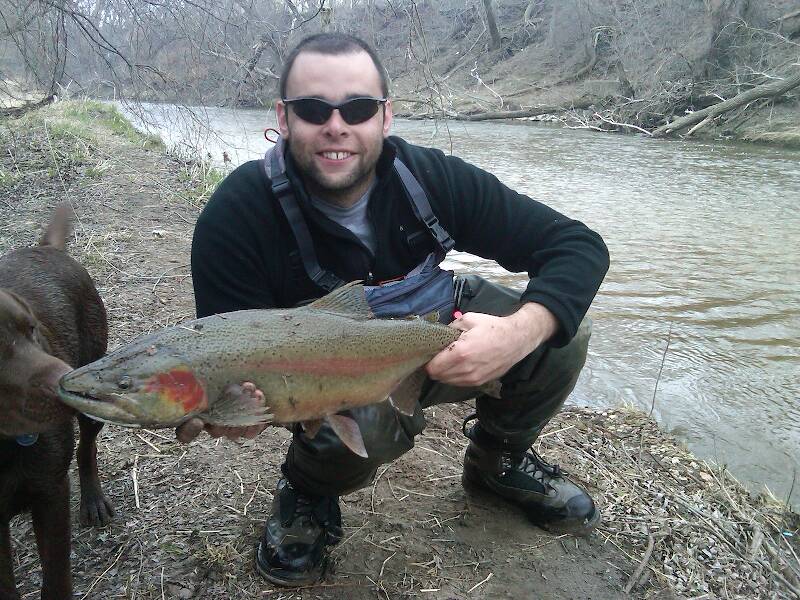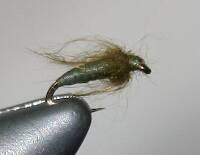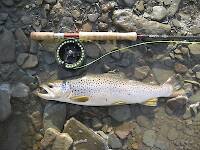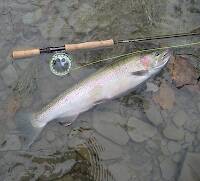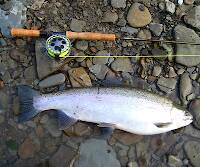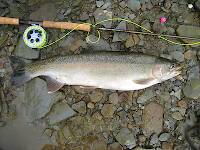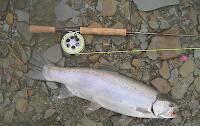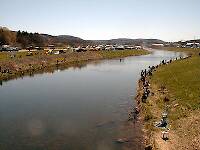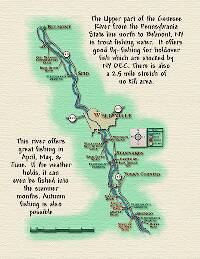
Salmonflies
Pteronarcys californica
The giant Salmonflies of the Western mountains are legendary for their proclivity to elicit consistent dry-fly action and ferocious strikes.
Featured on the forum

This species was fairly abundant in a February sample of the upper Yakima.

Troutnut is a project started in 2003 by salmonid ecologist Jason "Troutnut" Neuswanger to help anglers and
fly tyers unabashedly embrace the entomological side of the sport. Learn more about Troutnut or
support the project for an enhanced experience here.
Outdoors198
Posts: 27
Posts: 27
Outdoors198 on Sep 22, 2015September 22nd, 2015, 5:04 pm EDT
Hey all! I had read something not too long ago about flies drifting downstream past your split shot(or other weight), hence making it very difficult to detect any hits on your fly. This is with the classic "2 fly, split shot 12 to 18 inches above the top fly" rig. I've since read about bounce nymphing rigs where the weight is on the bottom (where legal) and was wondering what your thoughts/experiences have been regarding these 2 rigs. Thanks!
Martinlf on Sep 22, 2015September 22nd, 2015, 5:48 pm EDT
I generally prefer rigs where I can be tight to the nymphs, such as Euro nymph rigs, or drop shot/bounce rigs. I think I hook more fish that way, at least when the fish are taking the fly with these sorts of rigs. But at times having a nymph that moves a bit or is able to conform to the flow more naturally seems to work better. At such times I'll use a standard rig with split shot 4-12" from the point fly. To me learning as many styles and approaches as possible, being ready to adapt them to the overall conditions, seems ideal. George Daniels' book, Dynamic Nymphing describes a number of rigs and situations in which they may work. It is a good reference to begin to contemplate such, though I don't recall whether or not he discusses bounce nymph rigs per se.
"He spread them a yard and a half. 'And every one that got away is this big.'"
--Fred Chappell
--Fred Chappell
Outdoors198
Posts: 27
Posts: 27
Outdoors198 on Sep 22, 2015September 22nd, 2015, 5:59 pm EDT
I have his book and it is excellent but I don't believe he ever mentions bounce nymphing.
Kschaefer3 on Sep 23, 2015September 23rd, 2015, 5:20 am EDT
Hey all! I had read something not too long ago about flies drifting downstream past your split shot(or other weight), hence making it very difficult to detect any hits on your fly. This is with the classic "2 fly, split shot 12 to 18 inches above the top fly" rig. I've since read about bounce nymphing rigs where the weight is on the bottom (where legal) and was wondering what your thoughts/experiences have been regarding these 2 rigs. Thanks!
When I was on the Beaverhead, all the shops showed me a variation of this rig. They put a LOT of weight on the bottom and then tie two loops above. Each loop receives a 2-4" piece of tippet and a fly off the tippet. From what I was told, it is far and away the most productive way to nymph that river due to current and depth. You should see the guys floating the river fishing those though...chuck and duck.
Outdoors198
Posts: 27
Posts: 27
Outdoors198 on Sep 23, 2015September 23rd, 2015, 7:50 am EDT
Yeah I've read about those chuck and duck rigs too. Has anyone heard of the flies drifting past the weight in the classic 2 fly rig I mentioned?
TNEAL on Sep 23, 2015September 23rd, 2015, 8:03 am EDT
much easier to fish weight with a spinning outfit
Kschaefer3 on Sep 23, 2015September 23rd, 2015, 8:48 am EDT
Yeah I've read about those chuck and duck rigs too. Has anyone heard of the flies drifting past the weight in the classic 2 fly rig I mentioned?
I have employed this technique before. I think about it as letting the nymph sit in the slower under current while the bobber floats the speed of the surface current. Almost like the flies are a pivot point, and the whole rig rotates around the flies. The way water pushes into some pools I've seen, this is the most effective way (that I found, or know of) to get the flies to drift naturally. I do think you take a hit to strike detection though, although I've caught plenty of fish doing it.
Outdoors198
Posts: 27
Posts: 27
Outdoors198 on Sep 23, 2015September 23rd, 2015, 11:46 am EDT
much easier to fish weight with a spinning outfit
I was taught how to nymph with the 2 fly method and split shot above the nymphs. I've caught fish well using that rig too but it never hurts to expand your horizons. I really appreciate all the great replies so far!
Martinlf on Sep 23, 2015September 23rd, 2015, 12:43 pm EDT
Has anyone heard of the flies drifting past the weight in the classic 2 fly rig I mentioned?
Yes, I have. If the weight is sufficient and the fly is light enough it only stands to reason that current will push the fly downstream of the weight, at least at times. I have not seen any video demonstrating this, and think that possibly most flies of any size are not always swept past the weight. But as my qualifications in the sentence above indicate, I just don't know.
"He spread them a yard and a half. 'And every one that got away is this big.'"
--Fred Chappell
--Fred Chappell
Wiflyfisher on Sep 23, 2015September 23rd, 2015, 3:24 pm EDT
Hey all! I had read something not too long ago about flies drifting downstream past your split shot(or other weight), hence making it very difficult to detect any hits on your fly. This is with the classic "2 fly, split shot 12 to 18 inches above the top fly" rig. I've since read about bounce nymphing rigs where the weight is on the bottom (where legal) and was wondering what your thoughts/experiences have been regarding these 2 rigs. Thanks!
I just returned from a week out in the West Yellowstone area. On the Madison River above Three Dollar Bridger I used 2 nymph pattern rig on Hanak and Hends barbless jig hooks with slotted tungsten beads. The nymph patterns got down to the fish and worked marvelously. I liked it much better than adding split shots and all that crap.


http://flypatternsfortrout.com/2015/09/02/tying-nymphs-with-competition-jig-hooks/
John S.
https://WiFlyFisher.com
https://WiFlyFisher.com
Catskilljon on Sep 24, 2015September 24th, 2015, 3:32 am EDT
Like Martinlf mentioned, I too like the bottom nymph as an anchor. The way I look at it, there is absolutely no way your going to feel every fish fishing nymphs, it doesn't matter what you do. Flies will drift around, stop, turn, go upstream...so many currents under there that you cant see.
The thing with nymphs is, any fish will take them, not just the frisky ones that take dry flies. You will certainly increase your catching using them, but you will never catch them all, you just cant feel every take. CJ
The thing with nymphs is, any fish will take them, not just the frisky ones that take dry flies. You will certainly increase your catching using them, but you will never catch them all, you just cant feel every take. CJ
Oldredbarn on Sep 24, 2015September 24th, 2015, 10:09 am EDT
Nice set up John...I like the ribbing material being the wire...I have tied "hot-spot" nymphs with red thread, but I like your method...Just a tad more weight using the wire.
How about a pictorial report from the Madison. :)
I have always been a catch-and-release guy so not completely up on the legality of some configurations, but I've heard that here in Michigan there are rules that prohibit the weight on the very bottom...The flies have to conform to some special spacing...distance from the weight...If I can find a regs book I'll share it...
The concern is with snagging...
There is also something we call here the "slinky-rig"...Heavy shot sealed off in parachute chord. This is at the end of the leader. There is a swivel attached at the weight and tippet material run off of that and the flies are attached to the ends of this tippet. The cord material quiets the shot and may help with sangs on the bottom of the river. It also helps in keeping the flies below the weight as it moves downstream.
Think this is a steelhead/salmon configuration.
Spence
How about a pictorial report from the Madison. :)
I have always been a catch-and-release guy so not completely up on the legality of some configurations, but I've heard that here in Michigan there are rules that prohibit the weight on the very bottom...The flies have to conform to some special spacing...distance from the weight...If I can find a regs book I'll share it...
The concern is with snagging...
There is also something we call here the "slinky-rig"...Heavy shot sealed off in parachute chord. This is at the end of the leader. There is a swivel attached at the weight and tippet material run off of that and the flies are attached to the ends of this tippet. The cord material quiets the shot and may help with sangs on the bottom of the river. It also helps in keeping the flies below the weight as it moves downstream.
Think this is a steelhead/salmon configuration.
Spence
"Even when my best efforts fail it's a satisfying challenge, and that, after all, is the essence of fly fishing." -Chauncy Lively
"Envy not the man who lives beside the river, but the man the river flows through." Joseph T Heywood
"Envy not the man who lives beside the river, but the man the river flows through." Joseph T Heywood
Outdoors198
Posts: 27
Posts: 27
Outdoors198 on Sep 24, 2015September 24th, 2015, 11:09 am EDT
I have checked the regulations several times here in Oregon just to make sure and you cannot have weight below the hook if you are specifically fishing for steelhead or salmon. Other than that it is OK to use. That is very true no matter what you do you cannot feel every single fish!
Quick Reply
Related Discussions
Topic
Replies
Last Reply



